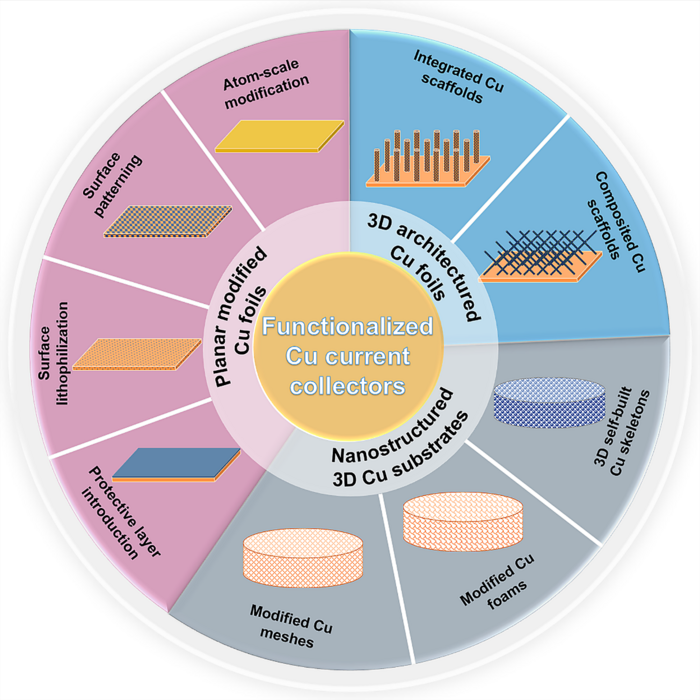Lithium metal exhibits great promise in terms of anode materials for the next-generation high-energy-density batteries. However, the problems with dendrite development and significant volume fluctuations associated with lithium plating and stripping can cause rapid capacity fading and safety issues, preventing the practical use of lithium metal anodes from being reached.
 Schematic shows how researchers divided the functionalized copper current collectors into three categories, according to their structural design concepts: planar modified copper foils, 3D architecture copper foils, and nanostructured 3D copper substrates. Image Credit: Nano Research Energy, Tsinghua University Press
Schematic shows how researchers divided the functionalized copper current collectors into three categories, according to their structural design concepts: planar modified copper foils, 3D architecture copper foils, and nanostructured 3D copper substrates. Image Credit: Nano Research Energy, Tsinghua University Press
Functionalized copper current collectors have the potential to stabilize the lithium metal anodes while also being simple to manufacture, inexpensive, and well-suited for use with current battery technology. A research team conducted a review study to offer a thorough overview of copper-based current collectors.
Their research clarifies the importance of comprehending current collector engineering for lithium metal batteries with high energy densities.
The team’s study focused on the current collectors, which link external circuits and lithium metal batteries. They support Li metal deposition and dissolution in addition to gathering electrical current and delivering it to the external circuits.
In their analysis, the research team focuses on the concepts and methods used in designing copper current collectors to maximize the behaviors of lithium plating and stripping. They also list the important problems that still need to be resolved and suggest areas for future research.
Functionalized copper current collectors exhibit great potential for stabilizing lithium metal anodes because of their facile fabrication and good electrical conductivity.
Yuhang Liu, Ph.D. Student, Department of Materials Science, Northwestern Polytechnical University
The team divided the functionalized copper current collectors into three groups for the study’s purposes: 1) copper foils with planar modifications, 2) copper foils with 3D architectures, and 3) copper substrates with nanostructures.
The design concepts of the copper current collectors and the associated mechanistic insights into the lithium deposition behavior were systematically summarized.
The team found that the planar-modified copper foils had significantly improved lithium plating and stripping processes.
The team concluded that copper foils with 3D architecture make excellent current collectors for stabilizing lithium nucleation and deposition, particularly when high current density and cycling capacity are present.
The team discovered that dendrite-free lithium metal anodes with long-term stability and high-rate capability could be produced using nanostructured 3D copper substrates.
Scientists have significantly improved the electrochemical performances of lithium metal anodes by developing functionalized copper current collectors. The practical applications of lithium metal anodes are still constrained by problems that need to be resolved. The research team suggests several areas for further research.
Future research is advised to be done on the following topics: 1) anode-free lithium metal batteries based on functionalized copper-based current collectors; 2) evaluation of lithium plating and stripping behaviors under extreme conditions; 3) extension and exploration from coin cells to pouch cells; and 4) dynamic monitoring of the lithium plating and stripping process within copper-based current collectors.
Liu added, “To sum up, functionalized copper current collectors have exhibited high-efficiency in stabilizing lithium plating and stripping, which guarantees promising electrochemical performance of lithium metal batteries.”
The functionalized copper-based current collectors can also be added to other energy-storage systems, such as lithium-ion batteries, sodium-ion or sodium metal batteries, or supercapacitors, due to their exceptional conductivity, robust structural stability, and ease of fabrication.
The team aspires to develop anode-free lithium metal batteries for use in practical applications in the future.
“Our ultimate goal of developing functionalized copper-based current collectors is dendrite-free lithium growth, highly-reversible lithium plating and stripping, and ultralong cycling lifespan,” Liu further added.
The research team consists of Chuntai Liu from Zhengzhou University, Qingyu Yan from Nanyang Technological University and A*STAR, and Yuhang Liu, Yifan Li, Jinmeng Sun, Zhuzhu Du, Xiaoqi Hu, Jingxuan Bi, and Wei Ai from Northwestern Polytechnical University.
The National Natural Science Foundation of China, the National Key Research and Development Program of China, the Ministry of Education of Singapore, and the 111 Project from Zhengzhou University all provided funding for this study.
Journal Reference:
Liu, Y., et al. (2022) Present and future of functionalized Cu current collectors for stabilizing lithium metal anodes. Nano Research Energy. doi:10.26599/NRE.2023.9120048.